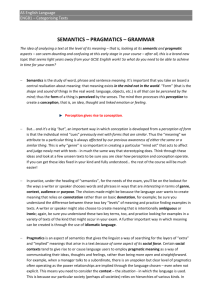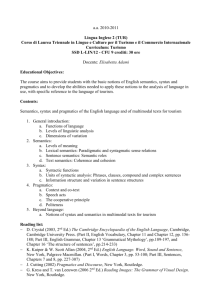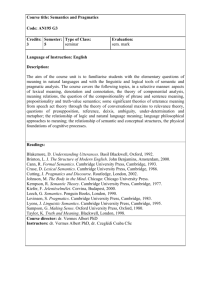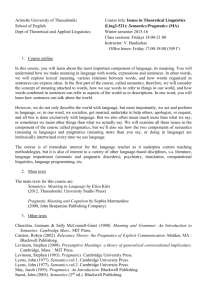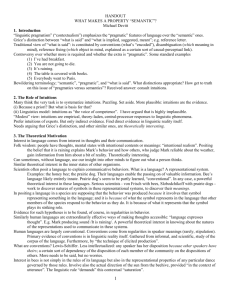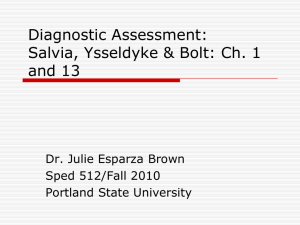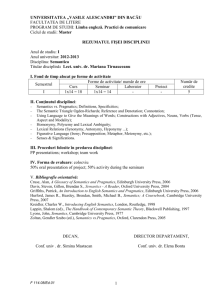Semantics Workshop 1 - University of Cambridge
advertisement
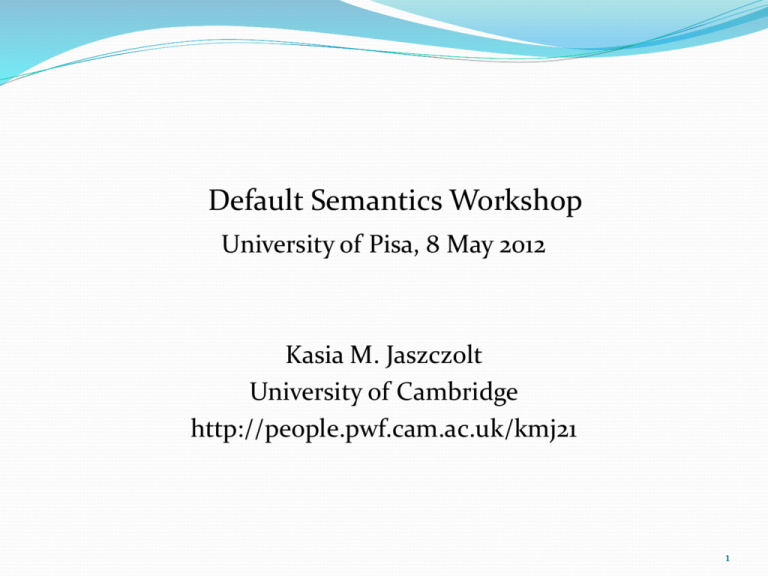
Default Semantics Workshop University of Pisa, 8 May 2012 Kasia M. Jaszczolt University of Cambridge http://people.pwf.cam.ac.uk/kmj21 1 Part 1 Default Semantics and Interactive Semantics: An introduction Part 2 Selected applications: Temporal reference in discourse Part 3 Selected applications: First-person reference in discourse and beliefs de se 2 Part 1 Default Semantics and Interactive Semantics: An introduction Part 2 Selected applications: Temporal reference in discourse Part 3 Selected applications: First-person reference in discourse and beliefs de se 3 Outline The Gricean legacy Minimalism vs. contextualism debates Interactive Semantics as a radical contextualist theory 4 Paul Grice: Intentions ‘A meantNN something by x’: A uttered x with the intention of inducing a belief by means of the recognition of this intention. Grice 1957 in 1989, p. 219 5 Implicature (implicatum) Inferences that are drawn from an utterance. They are seen by the hearer as being intended by the speaker. Speakers implicate, hearers infer (Horn 2004). 6 Implicature (implicatum) Inferences that are drawn from an utterance. They are seen by the hearer as being intended by the speaker. Speakers implicate, hearers infer (Horn 2004). Inference in implicature is cancellable: ‘Tom has three children.’ ‘Tom has three children, if not four.’ vs. deductive inference: ((p → q) ∧ p) → q) 7 Modified Occam’s Razor: ‘Senses are not to be multiplied beyond necessity.’ Grice 1978 in 1989, p.47 8 Post-Gricean pragmatics: ? Where is the boundary between semantics and pragmatics? 9 Contextualism (currently dominant view) ‘... what is said turns out to be, in a large measure, pragmatically determined. Besides the conversational implicatures, which are external to (and combine with) what is said, there are other nonconventional, pragmatic aspects of utterance meaning, which are constitutive of what is said.’ Recanati (1989: 98; see also Recanati 2005, 2010) 10 Some British people like cricket. Some but not all British people like cricket. Everybody read Frege. Every member of the research group read Frege. 11 Semantic analysis takes us only part of the way towards the recovery of utterance meaning. Pragmatic enrichment completes the process. Enrichment: some +> some but not all everybody +> everybody in the room, every acquaintance of the speaker, etc. 12 Pragmatic enrichment of what is said is often automatic, subconscious (Dafault/Interactive Semantics: ‘default’). 13 Truth-Conditional Pragmatics (Recanati 2004, 2010) Truth conditions of an utterance are determined not only by the assignment of values to indexicals (saturation) but also by modulation (top-down pragmatic processes). Recanati (2004: 90) = contextualism 14 Modulation (Recanati 2004, 2005): The logical form becomes enriched/modulated as a result of pragmatic inference and the entire semantic/pragmatic product becomes subjected to the truth-conditional analysis. 15 Modulation (Recanati 2004, 2005): The logical form becomes ?enriched/modulated as a result of pragmatic inference and the entire semantic/pragmatic product becomes subjected to the truth-conditional analysis. 16 Beyond contextualism ? How far can the logical form be extended? ‘How much pragmatics’ is allowed in the representation of the primary intended meaning of an utterance? 17 Semantic Minimalism Minimal Semantics, Emma Borg (e.g. 2004, 2007) Semantic theory must remain unaffected by pragmatic considerations. Semantics is confined sentence meaning and to accounting for deductive, formal operations. “The truth-conditional semantic theory is governed, not by rich (…) inferential processes, but rather by formally triggered, deductive operations.” Borg (2004: 8) 18 ‘That is red’ is true iff the contextually salient object is red. ‘Steel isn’t strong enough’ is true iff steel isn’t strong enough for something or other, salient in the context. 19 Semantic Minimalism? Insensitive Semantics, Cappelen and Lepore (e. g. 2005) A truth condition can be produced for a sentence even if we are not in a position to discern possible situations that would verify it. It is a mistake to assume that a semantic theory should account for speakers’ intuitions about the content of the utterance, i.e. about the speaker’s meaning. 20 Semantic Minimalism ? Insensitive Semantics, Cappelen and Lepore (e. g. 2005) A truth condition can be produced for a sentence even if we are not in a position to discern possible situations that would verify it. It is a mistake to assume that a semantic theory should account for speakers’ intuitions about the content of the utterance, i.e. about the speaker’s meaning. Semantically context-sensitive expressions: personal pronouns (‘I’, ‘he’); demonstrative pronouns (‘this’, ‘that’); adverbs (‘here’, ‘there’, ‘now’, ‘today’, ‘yesterday’, ‘tomorrow’, ‘ago’, ‘henceforth’); adjectives (‘actual’ and ‘present’); tense. 21 Radical Semantic Minimalism, Bach (e. g. 2004, 2007) “The semantics-pragmatics distinction is not fit to be blurred. What lies on either side of the distinction, the semantic and the pragmatic, may each be messy in various ways, but that doesn’t blur the distinction itself. Taken as properties of sentences, semantic properties are on a par with syntactic and phonological properties: they are linguistic properties. Pragmatic properties, on the other hand, belong to acts of uttering sentences in the course of communicating.” Bach (2004: 27) against propositionalism 22 State of the Art: There are several contextualist approaches to semantics and several minimalist ones and the debate is continuing. 23 Towards radical contextualism ? How far can the logical form be extended? ‘How much pragmatics’ is allowed in the representation of the primary intended meaning of an utterance? 24 Default Semantics (Jaszczolt 2005, 2009, 2010) Interactive Semantics (Jaszczolt, in progress, OUP) Parsimony of Levels Principle (POL): Levels of senses are not to be multiplied beyond necessity. A: B: I’ve cut my finger. You are not going to die! Primary, main meaning: ‘There is nothing to worry about.’ 25 Default Semantics abandons the syntactic constraint adopted on other post-Gricean contextualist accounts according to which the explicit content (explicature, what is said) has to be the development of the logical form (i.e. has to be added to the output of syntactic processing) of the sentence. Primary meaning is defined as the most salient meaning intended by the speaker and recovered by the addressee and it may sometimes override the logical form of the sentence, as in B above. 26 Primary Intention Principle (PI): The primary role of intention in communication is to secure the referent of the speaker's utterance. ‘The winner of the Nobel Prize for literature 2010 is a good writer.’ referential (Mario Vargas Llosa) > attributive (whoever received the prize) 27 Degrees of Intentions Principle (DI): Intentions come in various strength, i.e. they allow for degrees. ‘Ralph believes that the best architect designed Sagrada Família.’ de re (Antoni Gaudí) > de dicto1 (Simon Guggenheim) > de dicto2 (whoever designed that church) 28 Merger representations What is expressed in the lexicon in one language may be expressed by grammar in another. 29 Merger representations What is expressed in the lexicon in one language may be expressed by grammar in another. What is expressed overtly in one language may be left to pragmatic inference or default interpretation in another. 30 e.g. sentential connectives: Wari’ (Chapacura-Wanham, the Amazon) Tzeltal (Mayan, Mexico) no ‘or’ Maricopa (Yuman, Arizona) Guugu Yimithirr (Australian Aboriginal) no ‘and’ no ‘if’ cf. Mauri & van der Auwera 2012.; Evans & Levinson 2009 31 English ‘and’ Tom finished the chapter and closed the book. and +> and then Tom finished the chapter and then closed the book. Tom finished the chapter. He closed the book. 32 rhetorical structure rules, Asher and Lascarides 2003 Narration: Tom finished the chapter. He closed the book. e1 e2 33 No ‘or’ in Wari’? Absence of a disjunctive marker presence of some irrealis marker ’am perhaps ’e’ live ca ’am mi’ 3SG.M. Perhaps give pin ca complete 3SG.M. ‘Either he will live or he will die.’ from Mauri and van der Auwera (2012: 391) 34 ‘…while perhaps none of the logical connectives are universally lexically expressed, there is no evidence that languages differ in whether or not logical connectives are present in their logical forms’. von Fintel & Matthewson (2008: 170) 35 Composition of meaning Ascribing generative capacity to syntax (Chomsky and followers) Compositionality as a property of semantics Montague and followers, e.g. DRT, DPL, representationalism Evans and Levinson (2009), generative power of semantics/pragmatics (conceptual structure) 36 Pragmatic, interactive compositionality (post-Gricean contextualists, e.g. Recanati’s Truth-Conditional Pragmatics; Jaszczolt’s Default Semantics) 37 von Fintel and Matthewson (2008: 191): ‘We found that languages often express strikingly similar truth conditions, in spite of non-trivial differences in lexical semantics or syntax. We suggested that it may therefore be fruitful to investigate the validity of ‘purely semantic’ universals, as opposed to syntax-semantics universals’. 38 What are they? vF&M (2008): (i) some universal semantic composition principles (ii) Gricean principles of utterance interpretation semantic/pragmatic processing principles 39 ‘For our generativist critics, generality is to be found at the level of structural representation; for us, at the level of process’ Evans and Levinson (2009: 475) 40 Compositionality is a semantic universal 41 Conceptual structure in Default Semantics Unit of analysis Sources of information contributing to the unit Pragmatic compositionality Merger representations: towards a formalization 42 ? How far can the logical form be extended? ‘How much pragmatics’ is allowed in the semantic representation? 43 The logical form of the sentence can not only be extended but also replaced by a new semantic representation when the primary, intended meaning demands it. Such extensions or substitutions are primary meanings and their representations are merger representations in Default Semantics. There is no syntactic constraint on merger representations. 44 Object of study of the theory of meaning: Discourse meaning intended by Model Speaker and recovered by Model Addressee (primary meaning) 45 Radical contextualism? DS does not recognize the level of meaning at which the logical form is pragmatically developed/modulated as a real, interesting, and cognitively justified construct. To do so would be to assume that syntax plays a privileged role among various carriers of information (contextualists’ mistake). 46 Child to mother: Everybody has a bike. (a) All of the child’s friends have bikes. (b) Many/most of the child’s classmates have bikes. (c) The mother should consider buying her son a bike. (d) Cycling is a popular form of exercise among children. 47 Child to mother: Everybody has a bike. (a) All of the child’s friends have bikes. (b) Many/most of the child’s classmates have bikes. (c) The mother should consider buying her son a bike. (d) Cycling is a popular form of exercise among children. 48 Child: Mother: (a) (b) Can I climb the Leaning Tower? You are too small. The child is too small to climb the Leaning Tower of Pisa. The child can’t climb the Leaning Tower of Pisa. 49 Child: Mother: (a) (b) Can I climb the Leaning Tower? You are too small. The child is too small to climb the Leaning Tower of Pisa. The child can’t climb the Leaning Tower of Pisa. 50 Interlocutors frequently communicate their main intended content through a proposition which is not syntactically restricted. Experimental evidence: Nicolle and Clark 1999 Pitts 2005 Sysoeva and Jaszczolt 2007 Schneider 2009 51 Merger Representation Primary meanings are modelled as the so-called merger representations. 52 Merger Representation Primary meanings are modelled as merger representations. The outputs of sources of information about meaning merge and all the outputs are treated on an equal footing. 53 Merger Representation Primary meanings are modelled as the so-called merger representations. The outputs of sources of information about meaning merge and all the outputs are treated on an equal footing. The syntactic constraint is abandoned. Merger representations have the status of mental representations. 54 Merger Representation • Primary meanings are modelled as merger representations. • The outputs of sources of information about meaning merge and all the outputs are treated on an equal footing. The syntactic constraint is abandoned. • Merger representations have the status of mental representations. • They have a compositional structure: they are proposition-like, truth-conditionally evaluable constructs. 55 Sources of information for (i) world knowledge (WK) (ii) word meaning and sentence structure (WS) (iii) situation of discourse (SD) (iv) properties of the human inferential system (IS) (v) stereotypes and presumptions about society and culture (SC) 56 SC A Botticelli was stolen from the Uffizi last week. A painting by Botticelli was stolen from the Uffizi Gallery in Florence last week. 57 IS The author of Wolf Hall is visiting Cambridge this spring. Hilary Mantel is visiting Cambridge this spring. 58 world knowledge (WK) word meaning and sentence structure (WS) merger representation Σ situation of discourse (SD) stereotypes and presumptions about society and culture (SC) properties of human inferential system (IS) Fig. 1: Sources of information contributing to a merger representation Σ 59 The model of sources of information can be mapped onto types of processes that produce the merger representation of the primary meaning and the additional (secondary) meanings. 60 Primary meaning: combination of word meaning and sentence structure (WS) merger representation Σ social, cultural and cognitive defaults (CD) world-knowledge defaultspm (SCWDpm) conscious pragmatic inference pm (from situation of discourse, social and cultural assumptions, and world knowledge) (CPIpm) Secondary meanings: Social, cultural and world-knowledge defaultssm (SCWDsm) conscious pragmatic inferencesm (CPIsm) Fig. 2: Utterance interpretation according to the processing model of the revised version of Default Semantics 61 Mapping between sources and processes WK SC WS SD IS SCWD or CPI SCWD or CPI WS (logical form) CPI CD In building merger representations DS makes use of the processing model and it indexes the components of with a subscript standing for the type of processing. 62 Merger representations are compositional. 63 Compositionality is a methodological principle: ‘…it is always possible to satisfy compositionality by simply adjusting the syntactic and/or semantic tools one uses, unless that is, the latter are constrained on independent grounds.’ Groenendijk and Stokhof (1991: 93) 64 or: Compositionality should be an empirical assumption about the nature of possible human languages. Szabó (2000) 65 Fodor (2008) compositionality on the level of referential properties (for Mentalese) 66 Selected applications of DS Origins: Jaszczolt 1992, 1999. Parsimony of Levels (POL) Principle: Levels of senses are not to be multiplied beyond necessity. First applications: definite descriptions, proper names, and belief reports (Jaszczolt 1997, 1999); negation and discourse connectives (Lee 2002); presupposition, sentential connectives, number terms (Jaszczolt 2005) Recent applications: temporality, and modality (Jaszczolt 2009; Srioutai 2004, 2006; Jaszczolt and Srioutai 2012; Engemann 2008; Jaszczolt forthcoming a,b); syntactic constraint on primary meaning (Sysoeva and Jaszczolt 2007; Schneider 2009; Jaszczolt 2012); first-person reference and de se belief reports (Jaszczolt forthcoming c, d) 67 Definite NPs in English The author of Wolf Hall is coming to Cambridge. The author of Wolf Hall (whoever he or she is) is coming to Cambridge. Hilary Mantel is coming to Cambridge. Michael Morpurgo is coming to Cambridge. 68 Degrees of Intentions (DI) Principle: Intentions and intentionality allow for degrees. Primary Intention (PI) Principle: The primary role of intention in communication is to secure the referent of the speaker’s utterance. Jaszczolt (1999: xix) 69 x [Hilary Mantel]CD (x) [[x]CD is coming to Cambridge]]WS Fig. 3: Partial merger representation for the default referential reading of ‘The author of Wolf Hall is coming to Cambridge’. 70 x [Michael Morpurgo]CPIpm (x) [[x]CPIpm is coming to Cambridge]]WS Fig. 4: Partial merger representation for the referential mistake reading of ‘The author of Wolf Hall is coming to Cambridge’. 71 xy [Wolf Hall]CD (y) [the author of y]WS, CPIpm (x) [[x]CPIpmis coming to Cambridge]]WS Fig. 5: Partial merger representation for the attributive reading of ‘The author of Wolf Hall is coming to Cambridge’. 72 Cancellability and the syntactic constraint (Jaszczolt 2009b) H1 Cancellability applies equally to explicit and implicit content. H2 Primary meanings, be it explicit or implicit, are more difficult to cancel than secondary meanings. 73 Cancellation of explicit meaning which functions as secondary meaning A and B are talking about a family dinner, remarking on the fact that it consisted of five courses. A: Was the food good? B: Some people liked mum’s cake. (+>PM The food at the family dinner was not particularly good.) (+>SM Some but not all people liked mum’s cake.) In fact, all of them did but this didn’t save the dinner. = non-arising or promptly cancelled 74 (ii) Primary meaning cancelled x A and B are talking about a family dinner. A: Was the food good? B: Some people liked mum’s cake. (+>PM The food at the family dinner was not particularly good.) But that is not to say that other courses were bad, I was late and arrived only for the dessert. = pragmatically ill-formed 75 Potential ‘implicatures’ functioning as primary meanings differ from potential ‘implicatures’ functioning as secondary meanings with respect to the property of cancellability. Potential main, intended meanings are considerably entrenched. 76 Cancellation supports the DS primary/secondary meaning distinction and the rejection of the Syntactic Constraint 77 Summary Radical contextualism without the syntactic constraint Primary/secondary distinction as orthogonal to the explicit/implicit distinction Pragmatic compositionality 78 Select references Asher, N. and A. Lascarides 2003. Logics of Conversation. Cambridge: Cambridge University Press. Bach, K. 2004. ‘Minding the gap’. In: C. Bianchi (ed.). The Semantics/Pragmatics Distinction. Stanford: CSLI Publications. 27-43. Bach, K. 2006. ‘The excluded middle: Semantic minimalism without minimal propositions’. Philosophy and Phenomenological Research 73. 435-442. Bach, K. 2007. ‘Regressions in pragmatics (and semantics)’. In: N. Burton-Roberts (ed.). Pragmatics. Basingstoke: Palgrave Macmillan. 24-44. Borg, E. 2004. Minimal Semantics. Oxford: Clarendon Press. Borg, E. 2007. ‘Minimalism vs contextualism in semantics’. In: Preyer, G. & G. Peter (eds). 2007. Context-Sensitivity and Semantic Minimalism. Oxford: Oxford University Press. 339-359. Cappelen, H. & E. Lepore. 2005. Insensitive Semantics. Oxford: Blackwell. Evans, N. and S. C. Levinson. 2009. ‘The myth of language universals: Language diversity and its importance for cognitive science’. Behavioral and Brain Sciences 32. 429-492. Fodor, J. A. 2008. LOT 2: The Language of Thought Revisited. Oxford: Clarendon Press. Grice, P. 1989. Studies in the Way of Words. Cambridge, MA: Harvard University Press. (especially ‘Logic and conversation’ ‘Further notes on logic and conversation’ ‘Meaning’). Groenendijk, J. and M. Stokhof. 1991. ‘Dynamic Predicate Logic’. Linguistics and Philosophy 14. 39-100. Horn, L. R. 2004. ‘Implicature’. In: L. R. Horn and G. Ward (eds). The Handbook of Pragmatics. Oxford: Blackwell. 3-28. Horn, L. R. 2007. ‘Neo-Gricean pragmatics: A Manichaean manifesto’. In: N. Burton-Roberts (ed.). Pragmatics. Basingstoke: Palgrave Macmillan. 158-183. 79 Jaszczolt, K. M. 1999. Discourse, Beliefs, and Intentions: Semantic Defaults and Propositional Attitude Ascription. Oxford: Elsevier Science. Jaszczolt, K.M. 2005. Default Semantics. Oxford: Oxford University Press. Jaszczolt, K. M. 2009a. Representing Time: An Essay on Temporality as Modality. Oxford: Oxford University Press. Jaszczolt, K. M. 2009b. ‘Cancellability and the primary/secondary meaning distinction’. Intercultural Pragmatics 6. 259-289. Jaszczolt, K.M. 2010a. ‘Default Semantics’. In: B. Heine and H. Narrog (eds). The Oxford Handbook of Linguistic Analysis. Oxford: Oxford University Press. 193-221. Jaszczolt, K. M. 2010b. ‘Semantics-pragmatics interface’. In: L. Cummings (ed.). The Pragmatics Encyclopedia. London: Routledge. 428-432. Jaszczolt, K. M. 2011. 'Communicating about the past through modality in English and Thai' (with J. Srioutai). In: A. Patard and F. Brisard (eds). Cognitive Approaches to Tense, Aspect, and Epistemic Modality. Amsterdam: J. Benjamins. 249-278. Jaszczolt, K. M. forthcoming a. 'Temporality and epistemic commitment: An unresolved question'. In: K. Jaszczolt and L. de Saussure (eds). Time: Language, Cognition, and Reality. Oxford: Oxford University Press. Jaszczolt, K. M. forthcoming b. 'Cross-linguistic differences in expressing time and universal principles of utterance interpretation'. In: L. Filipovic and K. Jaszczolt (eds). Space and Time in Languages and Cultures: Linguistic Diversity. Amsterdam: John Benjamins. Jaszczolt, K. M. forthcoming c. 'Contextualism and minimalism on de se belief ascription'. In: A. Capone and N. Feit (eds). Attitudes De Se: Linguistics, Epistemology, Metaphysics. Stanford: CSLI Publications. 80 Jaszczolt, K. M. forthcoming d. 'First-person reference in discourse: Aims and strategies'. Intercultural Pragmatics Special Issue 'Focus on the Speaker'. Mauri, C. and J. van der Auwera. 2012. ‘Connectives’. In: K. M. Jaszczolt and K. Allan (eds). The Cambridge Handbook of Pragmatics. Cambridge: Cambridge University Press. 377401. Pitts, A. 2005. ‘Assessing the evidence for intuitions about what is said’. M.Phil. essay, University of Cambridge. Recanati, F. 1989. ‘The pragmatics of what is said’. Mind and Language 4. Reprinted in: S. Davis (ed.). 1991. Pragmatics: A Reader. Oxford: Oxford University Press. 97-120. Recanati, F. 2004. Literal Meaning. Cambridge: Cambridge University Press. Recanati, F. 2005. ‘Literalism and contextualism: Some varieties’. In: G. Preyer and G. Peter (eds). Contextualism in Philosophy: Knowledge, Meaning, and Truth. Oxford: Clarendon Press. 171-96. Recanati, F. 2010. Truth-Conditional Pragmatics. Oxford: Clarendon Press. Schneider, A. 2009. Understanding Primary Meaning: A Study with Reference to Requests in Russian and British English. PhD dissertation, University of Cambridge. Sysoeva, A. and K. M. Jaszczolt, 2007. ‘Composing utterance meaning: An interface between pragmatics and psychology’. Paper presented at the 10th International Pragmatics Conference, Göteborg, July 2007. Szabò, Z. G. 2000. ‘Compositionality as supervenience’. Linguistics and Philosophy 23. 475505. von Fintel, K. and L. Matthewson. 2008. ‘Universals in semantics’. The Linguistic Review 25. 139-201. 81

